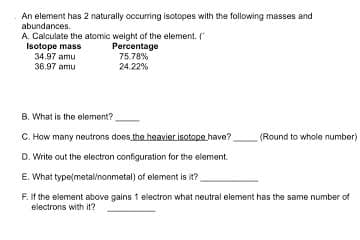An element has 2 naturally occurring isotopes with the following masses and abundances. A. Calculate the atomic weight of the element. ( Percentage 75.78% 24.22% Isotope mass 34.97 amu 36.97 amu B. What is the element? C. How many neutrons does the haavier.isotope have? (Round to whole number D. Write out the electron configuration for the element. E. What type(metalinonmetal) of olement is it? F. If the element above gains 1 electron what neutral element has the same number of electrons with it?
An element has 2 naturally occurring isotopes with the following masses and abundances. A. Calculate the atomic weight of the element. ( Percentage 75.78% 24.22% Isotope mass 34.97 amu 36.97 amu B. What is the element? C. How many neutrons does the haavier.isotope have? (Round to whole number D. Write out the electron configuration for the element. E. What type(metalinonmetal) of olement is it? F. If the element above gains 1 electron what neutral element has the same number of electrons with it?
Introductory Chemistry: An Active Learning Approach
6th Edition
ISBN:9781305079250
Author:Mark S. Cracolice, Ed Peters
Publisher:Mark S. Cracolice, Ed Peters
Chapter5: Atomic Theory : The Nuclear Model Of The Atom
Section: Chapter Questions
Problem 35E: Questions 31 through 36: Percentage abundances and atomic masses (u) of the natural isotopes of an...
Related questions
Question
please answer all parts

Transcribed Image Text:An element has 2 naturally occurring isotopes with the following masses and
abundances.
A. Calculate the atomic weight of the element. ("
Isotope mass
34.97 amu
36.97 amu
Percentage
75.78%
24.22%
B. What is the element?
C. How many neutrons does the heavier isotope have?
(Round to whole number)
D. Write out the electron configuration for the element.
E. What type(metal/nonmetal) of element is it?
F. If the element above gains 1 electron what neutral element has the same number of
electrons with it?
Expert Solution
This question has been solved!
Explore an expertly crafted, step-by-step solution for a thorough understanding of key concepts.
This is a popular solution!
Trending now
This is a popular solution!
Step by step
Solved in 3 steps with 1 images

Knowledge Booster
Learn more about
Need a deep-dive on the concept behind this application? Look no further. Learn more about this topic, chemistry and related others by exploring similar questions and additional content below.Recommended textbooks for you

Introductory Chemistry: An Active Learning Approa…
Chemistry
ISBN:
9781305079250
Author:
Mark S. Cracolice, Ed Peters
Publisher:
Cengage Learning

Introductory Chemistry: A Foundation
Chemistry
ISBN:
9781337399425
Author:
Steven S. Zumdahl, Donald J. DeCoste
Publisher:
Cengage Learning

Chemistry: Principles and Practice
Chemistry
ISBN:
9780534420123
Author:
Daniel L. Reger, Scott R. Goode, David W. Ball, Edward Mercer
Publisher:
Cengage Learning

Introductory Chemistry: An Active Learning Approa…
Chemistry
ISBN:
9781305079250
Author:
Mark S. Cracolice, Ed Peters
Publisher:
Cengage Learning

Introductory Chemistry: A Foundation
Chemistry
ISBN:
9781337399425
Author:
Steven S. Zumdahl, Donald J. DeCoste
Publisher:
Cengage Learning

Chemistry: Principles and Practice
Chemistry
ISBN:
9780534420123
Author:
Daniel L. Reger, Scott R. Goode, David W. Ball, Edward Mercer
Publisher:
Cengage Learning

World of Chemistry, 3rd edition
Chemistry
ISBN:
9781133109655
Author:
Steven S. Zumdahl, Susan L. Zumdahl, Donald J. DeCoste
Publisher:
Brooks / Cole / Cengage Learning

Chemistry: An Atoms First Approach
Chemistry
ISBN:
9781305079243
Author:
Steven S. Zumdahl, Susan A. Zumdahl
Publisher:
Cengage Learning
